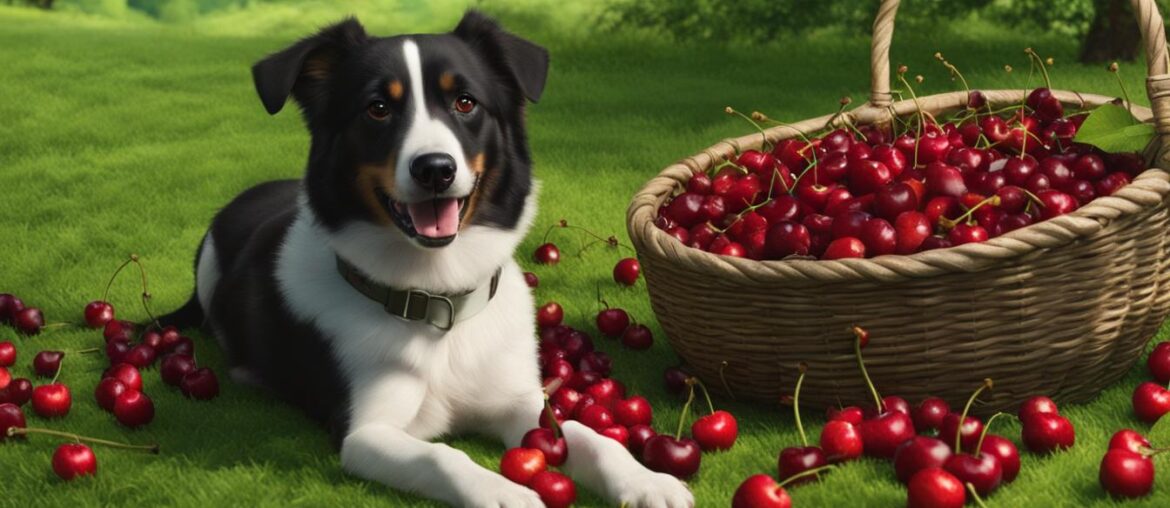When it comes to dogs and cherries, it’s important to understand the potential risks involved. While dogs can eat cherries without pits, there are certain precautions that need to be taken to ensure their safety. Cherries are generally considered a tasty and healthy snack for humans, but they can pose dangers to our furry friends.
The pits, stems, and leaves of cherries contain cyanide, a poisonous substance that can be lethal if consumed in large quantities. Ingesting cherry pits can also lead to intestinal blockages in dogs. Additionally, maraschino cherries, despite having the pits removed, are not suitable for dogs due to the high sugar content.
If your dog swallows a whole cherry, there is no immediate cause for concern, but it is important to watch for symptoms of intestinal blockage. If your dog consumes multiple cherries or exhibits symptoms of cyanide poisoning, it’s recommended to contact your vet immediately for guidance.
Key Takeaways:
- Dogs can eat cherries without pits, but precautions must be taken.
- Cherry pits, stems, and leaves contain cyanide and can be toxic to dogs.
- Maraschino cherries should be avoided due to their high sugar content.
- Contact your vet if your dog exhibits symptoms of cherry pit ingestion or cyanide poisoning.
- Always monitor your dog’s consumption and feed cherries in moderation.
Why Should You Use Caution When Feeding Dogs Cherries?
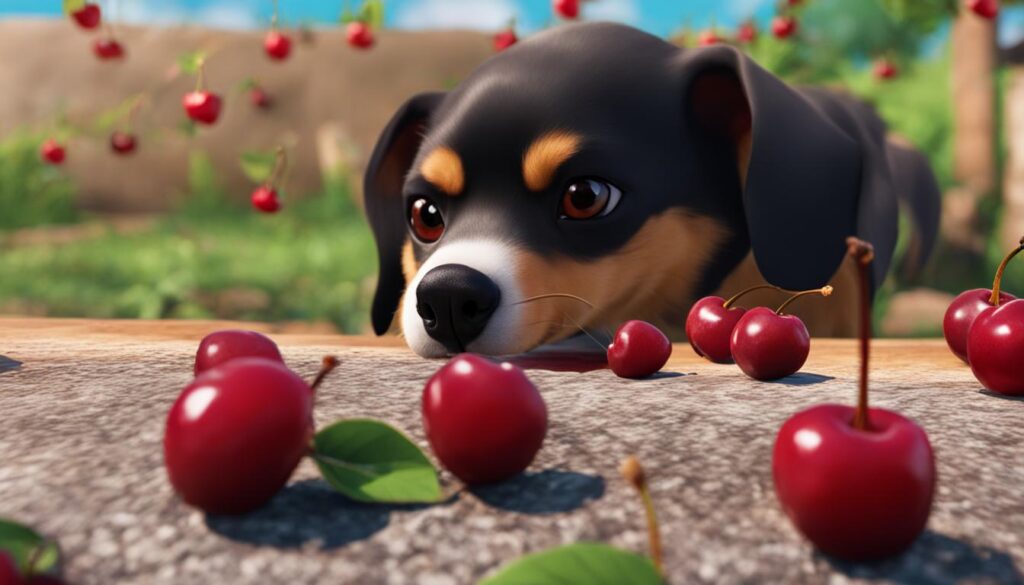
Feeding dogs cherries may seem harmless, but it is important to exercise caution due to the potential dangers involved. Cherries contain pits, stems, and leaves that can pose serious risks to your furry friend. These parts of the cherry contain cyanide, a toxic substance that can have adverse effects on your dog’s health if consumed in large quantities.
The cyanide found in cherry pits can lead to cyanide poisoning in dogs, which can result in breathing difficulties, organ damage, and even death. It is crucial to understand the symptoms of cyanide poisoning and be mindful of your dog’s behavior after consuming cherries.
“Prevention is always better than cure. It is crucial to be aware of the potential dangers and take necessary precautions to keep your furry friend safe.”
In addition to cyanide poisoning, feeding dogs cherries with pits can also lead to intestinal blockages. If your dog swallows the pit, it can get stuck in their digestive system, causing discomfort and serious complications. Symptoms of intestinal blockage may include vomiting, decreased appetite, constipation, and reduced fecal production.
Being vigilant and observant
It is important to be vigilant and observe your dog for any signs of distress after consuming cherries. Look out for unusual behavior, changes in appetite, vomiting, or other digestive issues. If you notice any of these symptoms, it is crucial to seek veterinary attention immediately. Quick action can help prevent further complications and ensure your dog’s well-being.
Remember that smaller dogs are more susceptible to blockages from smaller cherry pits, so extra caution should be exercised when feeding them cherries.
By understanding and being aware of these risks, you can make informed decisions about feeding cherries to your dog. It is always better to err on the side of caution and prioritize your dog’s safety and well-being.
| Dangers of Feeding Cherries to Dogs | Symptoms of Intestinal Blockage |
|---|---|
| Cyanide poisoning | Vomiting |
| Breathing difficulties | Decreased appetite |
| Organ damage | Constipation |
| Intestinal blockages | Reduced fecal production |
| Changes in behavior |
Are Unprocessed Cherries Safe for Dogs?

Dogs can safely consume unprocessed cherries, provided that precautions are taken. Fresh cherries that have been thoroughly washed and had their pits, stems, and leaves removed can be a beneficial addition to a dog’s diet. Cherries contain several valuable nutrients for dogs, including antioxidants, melatonin, vitamin A, vitamin C, and fiber. These nutrients can support a dog’s immune system, aid in digestion, and promote overall health. However, it is essential to feed cherries in moderation, as they also contain natural sugars that can lead to weight gain and other health issues if consumed excessively.
To ensure the safety of unprocessed cherries for dogs, it is crucial to:
- Thoroughly wash cherries to remove any dirt or pesticide residue.
- Remove the pits, stems, and leaves, as they can be toxic to dogs.
- Feed cherries in moderation as part of a balanced diet.
Incorporating unprocessed cherries into a dog’s diet can provide various health benefits due to their nutrient-rich composition:
| Nutrient | Benefits |
|---|---|
| Antioxidants | Help fight free radicals, reduce inflammation, and support a healthy immune system. |
| Melatonin | Promotes better sleep patterns, which can be beneficial for dogs with anxiety or sleep disturbances. |
| Vitamin A | Supports healthy vision, skin, and coat. |
| Vitamin C | Aids in collagen production, boosts immune function, and helps with wound healing. |
| Fiber | Assists with digestion and promotes bowel regularity. |
It is important to note that while unprocessed cherries are generally safe for dogs, individual sensitivities can vary. Some dogs may experience digestive upset or allergic reactions to cherries. Therefore, it is recommended to introduce cherries slowly and monitor your dog for any adverse reactions. If you notice any signs of discomfort or unusual symptoms, discontinue feeding cherries and consult your veterinarian for further guidance.
Risks of Feeding Cherries to Dogs with Diabetes or Obesity
Dogs with diabetes or obesity should exercise caution when consuming cherries due to their high sugar content. The natural sugars in cherries can disrupt blood sugar levels in diabetic dogs and contribute to weight gain in overweight or obese dogs. Feeding cherries consistently to dogs with diabetes or obesity can lead to various health risks, including the worsening of diabetes, joint issues, and overall poor health.
Cherries contain approximately 12 grams of sugar per 100 grams, which can significantly impact a dog’s blood sugar levels. Diabetic dogs require a carefully controlled diet to manage their condition, and the additional sugar from cherries can complicate their glucose regulation. Similarly, dogs battling obesity need to reduce their sugar intake to achieve or maintain a healthy weight.
It is crucial to consult with a veterinarian for the appropriate dietary recommendations if your dog has diabetes or is overweight. Your vet can provide personalized guidance on how to manage your dog’s condition while still ensuring their nutritional needs are met.
Health Risks of Cherries for Diabetic Dogs
Feeding cherries to dogs with diabetes can pose several health risks:
- Disrupted blood sugar levels: Cherries’ high sugar content can cause a spike in blood glucose levels, making it difficult for diabetic dogs to regulate their blood sugar properly.
- Increased insulin requirements: The excess sugar from cherries will require additional insulin for diabetic dogs, potentially complicating their insulin therapy management.
- Potential weight gain: Excessive sugar consumption can contribute to weight gain, which can worsen diabetes management and strain joints in overweight diabetic dogs.
It is essential to monitor your diabetic dog’s condition closely and work closely with your vet to develop an appropriate diet plan to manage their diabetes effectively.
Health Risks of Cherries for Obese Dogs
Feeding cherries to obese dogs can pose several health risks:
- Increased calorie intake: Cherries, although a natural and nutritious fruit, contain calories from their sugar content. Excessive calorie intake can hinder weight loss efforts in obese dogs.
- Weight gain: The high sugar content in cherries can contribute to weight gain in dogs, exacerbating the existing obesity issue and putting additional strain on their joints and overall health.
- Reduced nutrient-dense meals: Obesity often results from overfeeding or providing high-calorie treats in place of nutrient-dense meals. Choosing healthier alternatives to cherries can help ensure dogs receive proper nutrition while managing weight.
If your dog is obese, it is important to work with your veterinarian to develop a weight management plan that includes appropriate dietary choices and portion control.
| Type of Risk | Cherries and Diabetes in Dogs | Cherries and Obesity in Dogs |
|---|---|---|
| Disrupted blood sugar levels | High sugar content can cause blood glucose spikes in diabetic dogs. | Excessive sugar intake contributes to weight gain, which can worsen obesity and strain joints. |
| Increased insulin requirements | Additional sugar from cherries may require higher insulin dosage in diabetic dogs. | Excess calories from cherries hinder weight loss efforts in obese dogs. |
| Potential weight gain | Excessive sugar intake can contribute to weight gain, worsening diabetes management. | Cherry’s high sugar content contributes to weight gain, exacerbating obesity. |
Can Dogs Eat Other Types of Cherries?
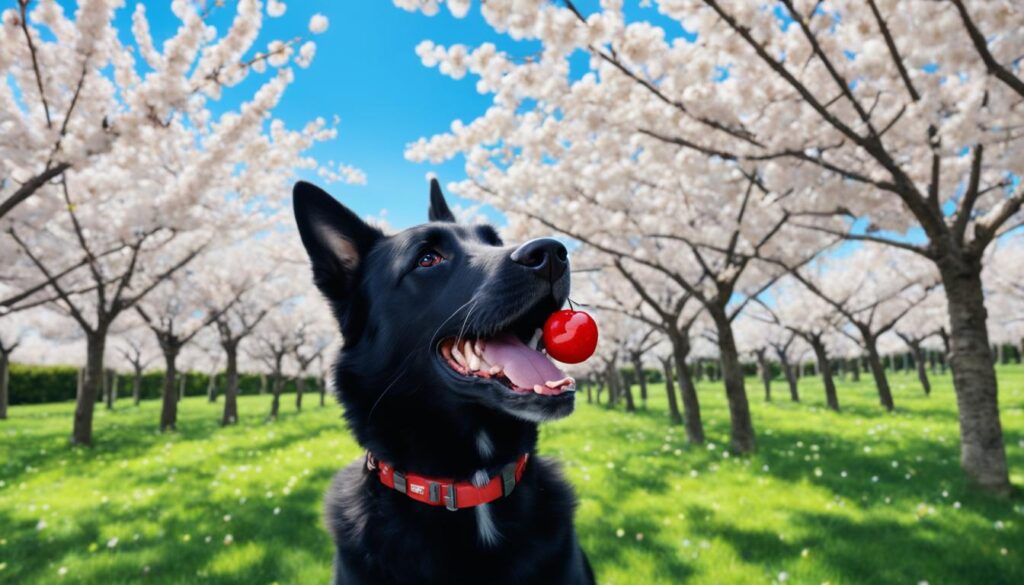
While unprocessed cherries without pits are generally safe for dogs, there are certain types of cherries that should be avoided. Let’s take a closer look at the safety of different cherry varieties for dogs:
1. Black Cherries and Dogs
Black cherries, also known as wild cherries, are not recommended for dogs. These bitter cherries contain cyanide and can be highly toxic if consumed by dogs. Cyanide poisoning can lead to serious health complications and even be fatal. It’s best to keep black cherries out of your dog’s reach to ensure their safety.
2. Maraschino Cherries and Dogs
Maraschino cherries, often used as a garnish for desserts, should not be given to dogs. These cherries are typically processed and soaked in sweet syrups that contain excessive amounts of sugar and preservatives. The high sugar content makes maraschino cherries unsuitable for canine consumption, as it can lead to weight gain and other health issues.
3. Wild Cherries and Dogs
Wild cherries, also known as bitter cherries or chokecherries, should never be fed to dogs. Similar to black cherries, wild cherries contain cyanide, which is highly toxic to dogs. It’s essential to keep your dog away from wild cherry trees and ensure they do not ingest these dangerous fruits.
4. Cherry Tomatoes and Dogs
Cherry tomatoes, although not true cherries, are safe for dogs when given in moderation. These small tomatoes can be a healthy treat for dogs, packed with essential nutrients like vitamin C and fiber. However, it’s important to remove the stems and leaves from cherry tomatoes before offering them to your furry friend.
It’s crucial to prioritize the safety of your canine companion when it comes to feeding cherries or any other food. By understanding the potential risks associated with certain cherry varieties, you can ensure that your dog remains healthy and happy.
How to Safely Feed Cherries to Your Dog
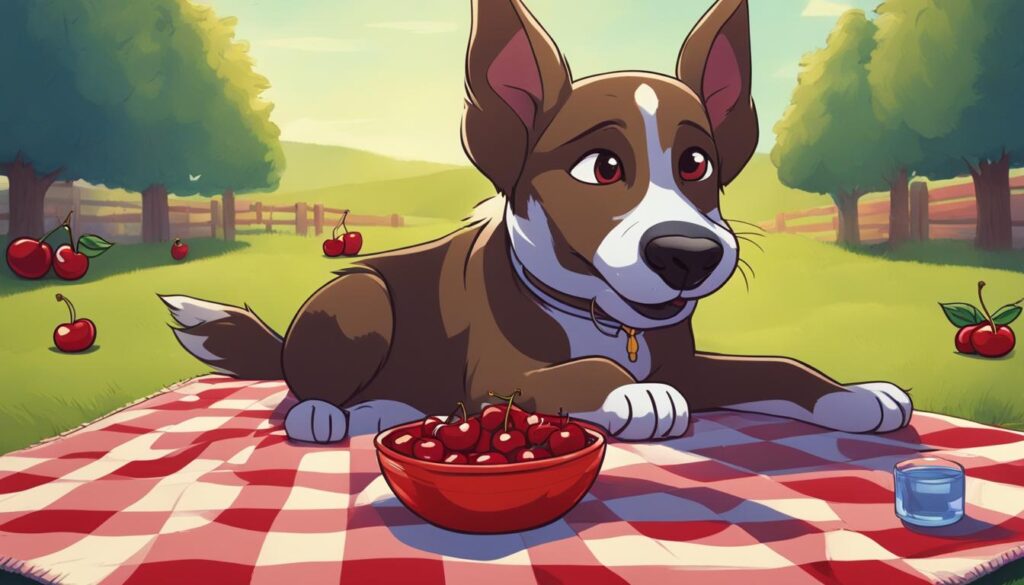
To ensure the safety of your dog when feeding cherries, it’s crucial to follow certain precautions. Here are some guidelines to help you feed cherries to your furry friend:
- Remove pits, stems, and leaves: Before offering cherries to your dog, make sure to remove all pits, stems, and leaves. Pits can be a choking hazard and cause intestinal blockages, while stems and leaves contain cyanide, which is toxic to dogs.
- Feed in moderation: Cherries contain natural sugars that can contribute to weight gain and other health issues if consumed excessively. It’s important to practice portion control and feed cherries as a small percentage of your dog’s overall diet.
If you have any concerns or notice any unusual symptoms after feeding cherries, consult with your veterinarian for personalized guidance. They can provide you with specific recommendations based on your dog’s individual needs and health condition.
Remember, the safety and well-being of your dog should always be a top priority when introducing new foods into their diet.
What to Do If Your Dog Shows Symptoms of Cherry Pit Ingestion

If your dog shows symptoms of cherry pit ingestion, such as vomiting, decreased appetite, constipation, or reduced fecal production, it is important to seek veterinary care. These symptoms may indicate an intestinal blockage, which can be a serious condition requiring medical intervention. Prompt veterinary attention can help diagnose and address the issue effectively, preventing further complications and discomfort for your dog.
If you notice any of the following symptoms in your dog after ingesting cherry pits, it is crucial to contact your veterinarian for immediate assistance:
- Vomiting
- Decreased appetite
- Constipation
- Reduced fecal production
These symptoms can indicate the presence of an intestinal blockage caused by cherry pit ingestion. Intestinal blockages occur when the pits obstruct the digestive tract, preventing the normal passage of food and causing discomfort and potential complications.
Your veterinarian will perform a thorough examination and may recommend diagnostic tests such as X-rays or ultrasound to assess the severity of the blockage. Depending on the size and location of the blockage, treatment options may include conservative management with a specialized diet and medication or surgical intervention to remove the obstruction.
Early veterinary care is crucial in cases of cherry pit ingestion to prevent further damage, such as perforation or rupture of the intestine, which can be life-threatening for your dog. It is important to follow the guidance of your veterinarian and provide any necessary follow-up care to ensure your dog’s recovery.
Remember, the best way to prevent cherry pit ingestion and potential intestinal blockage in dogs is to carefully remove pits, stems, and leaves from cherries before offering them as a treat or snack. Always prioritize your dog’s safety and well-being by providing a balanced and appropriate diet, including safe and nutritious foods.
Homemade Cherry Treats for Dogs
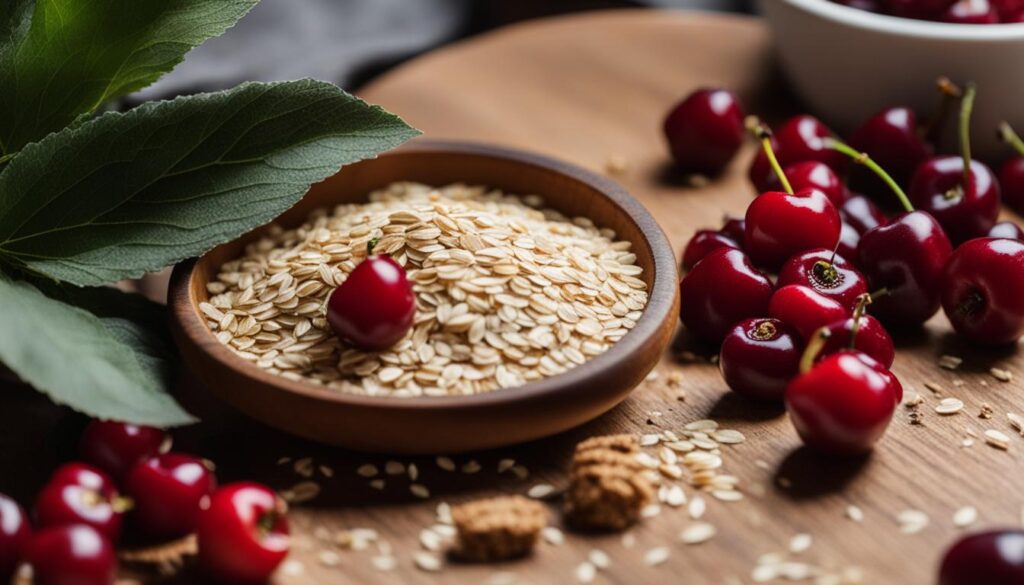
If you want to treat your dog to the taste of cherries, there are safe and delicious homemade options available. You can make homemade cherry dog treats using fresh cherries and other dog-safe ingredients. Here are a few cherry recipes for dogs that you can try:
Cherry Smoothie for Dogs
To make a cherry smoothie for dogs, blend fresh cherry pieces with dog-safe fruits like strawberries, bananas, and blueberries. This fruity blend can be served as a treat or used as a food topper to add a burst of flavor to your dog’s regular meals. It can also be frozen in a KONG toy for a refreshing cold treat on a hot day.
Frozen Cherry Yogurt for Dogs
If your dog enjoys frozen treats, you can create a cherry yogurt by blending cherry pieces with plain, sugar-free yogurt. Mix well and pour the mixture into ice cube trays or silicone molds. Freeze the cherry yogurt mixture, and your dog will have a tasty and refreshing frozen treat to enjoy on a warm day.
Cherry-Infused Dog Biscuits
If your dog enjoys crunchy treats, you can incorporate cherries into homemade dog biscuits. There are various dog-friendly recipes available online that use cherries as one of the ingredients. You can bake these biscuits using fresh cherries or even dried cherries, depending on your preference and what you have available.
Remember, moderation is key when giving homemade cherry treats to your dog. While cherries can offer nutritional benefits, they should only be given as an occasional treat and should not substitute a balanced and complete dog diet. Always consult with your veterinarian before introducing new ingredients or treats into your dog’s diet, especially if your dog has any specific dietary restrictions or health concerns.
Precautions When Cooking with Cherries for Dogs
If you are planning to incorporate cherries into dog-friendly recipes, it’s important to take precautions. Cooking with cherries for dogs can be a fun and nutritious way to treat your furry friend, but there are a few things to keep in mind to ensure their safety and well-being.
1. Avoid using cherry pits, stems, and leaves
When using cherries in dog recipes, always remove the pits, stems, and leaves. These parts of the cherries contain cyanide, which is toxic to dogs if ingested in large quantities. To prevent any potential harm, make sure to thoroughly clean and pit the cherries before including them in your dog’s meals or treats.
2. Mindful portion sizes and ingredient balance
While cherries can be a healthy addition to your dog’s diet, it’s crucial to consider portion sizes and the overall balance of ingredients in the recipe. Too many cherries, even without pits, can lead to digestive issues or weight gain in dogs. Consult with your veterinarian to determine the appropriate serving sizes and to ensure that the recipes align with your dog’s specific dietary needs.
3. Consult with your veterinarian
If you have any doubts or concerns about cooking with cherries for your dog, it’s always best to consult with your veterinarian. They can provide guidance on safe and nutritious recipes that incorporate cherries and address any questions or potential risks specific to your dog’s health.
By following these precautions, you can incorporate cherries into your dog’s diet safely and provide them with tasty and nutritious homemade treats or meals.
Wrapping Up
In conclusion, dogs can safely eat cherries without pits, provided certain safety measures are taken. Cherries are a nutritious fruit that can provide health benefits for dogs when fed in moderation.
However, it is crucial to remove the pits, stems, and leaves of cherries before feeding them to your dog. These parts contain cyanide and can be toxic if ingested in large quantities. By removing them, you eliminate the risk of cyanide poisoning and potential intestinal blockages.
It is also important to be mindful of the sugar content in cherries, as dogs with diabetes or obesity should avoid consuming them. The natural sugars in cherries can disrupt blood sugar levels and contribute to weight gain in these dogs.
If you have any doubts or notice any unusual symptoms after feeding cherries to your dog, it is always best to consult with a veterinarian. They can provide personalized guidance and ensure the health and well-being of your furry friend.
Remember, when introducing new foods into your dog’s diet, always prioritize their safety and make informed decisions based on their individual needs.
FAQ
Can dogs eat cherries without pits?
Yes, dogs can eat cherries without pits, but caution should be exercised due to the potential dangers associated with cherry pits.
Why should you use caution when feeding dogs cherries?
Caution should be used when feeding dogs cherries because cherry pits, stems, and leaves contain cyanide, which can be toxic to dogs if consumed in large quantities. Additionally, cherry pits can cause intestinal blockages in dogs.
Are unprocessed cherries safe for dogs?
Unprocessed cherries without pits can be safely consumed by dogs and provide several beneficial nutrients such as antioxidants, melatonin, vitamin A, vitamin C, and fiber.
What are the risks of feeding cherries to dogs with diabetes or obesity?
Cherries are high in sugar, so dogs with diabetes or obesity should avoid consuming them to prevent blood sugar fluctuations and weight gain.
Can dogs eat other types of cherries?
Dogs should avoid consuming wild cherries, also known as bitter cherries or chokecherries, as they contain cyanide. Maraschino cherries, which are often used as garnishes, are also unsuitable for dogs due to their high sugar content. However, cherry tomatoes are safe for dogs in small amounts.
How can cherries be safely fed to dogs?
To safely feed cherries to dogs, it is important to remove the pits, stems, and leaves and feed them in moderation as part of a balanced diet. Portion control should be based on the dog’s size.
What should you do if your dog shows symptoms of cherry pit ingestion?
If your dog exhibits symptoms such as vomiting, decreased appetite, constipation, or reduced fecal production after consuming cherry pits, seek veterinary care as these symptoms may indicate an intestinal blockage.
Are there homemade cherry treats for dogs?
Yes, you can make homemade cherry treats for dogs such as cherry smoothies blended with dog-safe fruits or mixing cherry pieces with plain, sugar-free yogurt for a cherry yogurt treat. These treats should be given in moderation.
What precautions should be taken when cooking with cherries for dogs?
When cooking with cherries for dogs, it is important to remove the pits, stems, and leaves and ensure that portion sizes and other ingredients align with the dog’s dietary needs. Consult with a veterinarian for safe and nutritious cherry recipes for dogs.
Can you summarize the safety guidelines for feeding dogs cherries?
Dogs can safely consume cherries without pits, but caution should be exercised. Remove pits, stems, and leaves before feeding cherries to dogs and feed them in moderation. Dogs with diabetes or obesity should avoid cherries due to their high sugar content. If any unusual symptoms occur, consult with a veterinarian for guidance.


